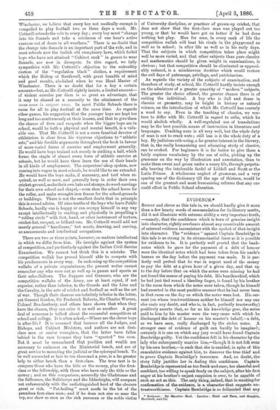EVIDENCE.*
BRIGHT and clever as this tale is, we should hardly give it more than a -few hearty words of commendation for its literary merits, did it not illustrate with-extreme ability a very important truth, —namely, that the confidence which is born of genuine insight into character, rightly-overbears almost any conceivable •amount of external evidence inconsistent with the upshot of that insight into character. The "evidence " against Captain Bembiidge in this tale is as strong in its circumstantial force as it is possible for evidence to be. It is perfectly well proved that the bank- notes which he gave for the payment of a debt of honour were the identical notes which had been taken from his uncle's bureau on the day before the payment was made. It is per- fectly well proVed that he was in urgent need of the money to pay the debt at a given hour of a given day, and that up to the day before that on which the notes were missing he had not found the means of paying his debt. His handkerchief, which he had just tied round a bleeding finger, is found by his brother in the room from which the notes.were taken, though he himself had asserted in the most positive manner that he had never been in that room on the day on which- the notes weredost. His-ser- vant (on whose trustworthiness neither he himself nor any one else casts any doubt, and who is, in fact, -perfectly trustworthy) positively asserts that, so far as his knowledge goes, the -notes paid to him by his master were the very same with which he discharged the debt of honour on his master's behalf,—a debt, as we have seen, really discharged by the stolen notes. A stronger ease of evidence of guilt can hardly be imagined ; certainly it is one on -which any jury would have found Captain Bembridge guilty. Yet the confidence felt in his chsraoter•bythe lady who subsequently marries him,—though it is not felt even by his own brother,—is.sneh that she is enabled, in spite of this cumulative evidence against him, to dissever the true thief and to prove Captain Bembridge's innocence. And, no doubt, the story fully justifies her in .feeling this confidence. Captain Bembridgeis represented as.too frank_andseasy, too cheerful and confident, too willing to speak freely on the subject, after his first anger at his brother's unjpst suspicion is over, to be capable of snob an act as this. The only, thing, indeed, that is.wanting for confirmation of the-evidence, is a character that suggests un- trustworthiness. Captain Bembridge is so delineated that any • Evidence. By Maurice Noel. London : Field and Thor, and Bimpkin, Marshall, and Co. well-constituted mind would have felt the impossibility of his having committed the theft, in spite of his urgent need of money, and in spite of the evidence caused by the presence of the blood- stained handkerchief in the room from which the notes were taken. There ought to have been no sort of doubt in any such mind, that there must have been some other way of accounting for the facts besides the guilt of the person incriminated. And that is precisely the value of the story, that it shows us of how much more value is the accumulation of those miscellaneous impres- sions extending over a considerable period, which produces faith in character, than any conceivable amount of circumstantial evidence which is inconsistent with the drift of those impressions. It is quite true, of course, that we cannot in any way array and analyse the evidence which has gone to produce this faith in character. It rests on a long chain of half-obliterated memories which it would be simply absurd even to try to recall. There is nothing to show for it but the feeling of absolute trust which remains. And yet it is more reasonable for those who feel that treat to act upon it and accept it unhesitatingly, than it is to rely on the most curious and startling evidence which tends to the undermining of that trust. This is a useful lesson to teach. And it is a lesson which, unlike most other lessons, may be taught by a story, without detracting in any way from the literary merit of the story. In this tale there is no necessity to warp characters in order to bring out the lesson intended, for the moral is a literary as well as a spiritual moral,—the far greater value of the evidence of character than of the evidence of circumstance. The characters here are all drawn with a cer- tain liveliness, and some of them even with precision. The tale, as a tale, is amusing. But it is even more instructive than amusing,—at least to those who will accept the teaching that they may trust the evidence of confident moral impressions far more implicitly than the evidence of what they call their senses and their understandings.



































 Previous page
Previous page